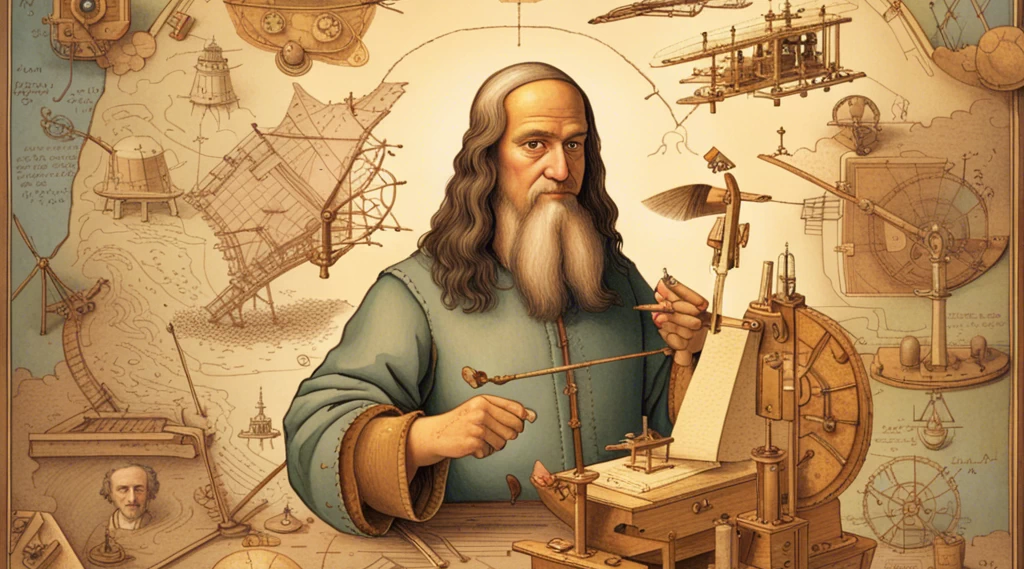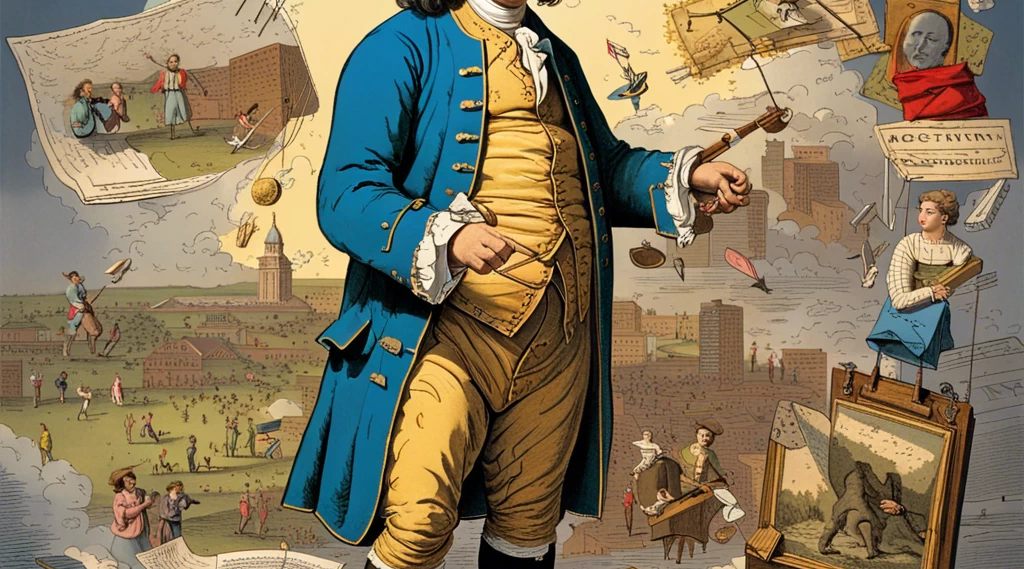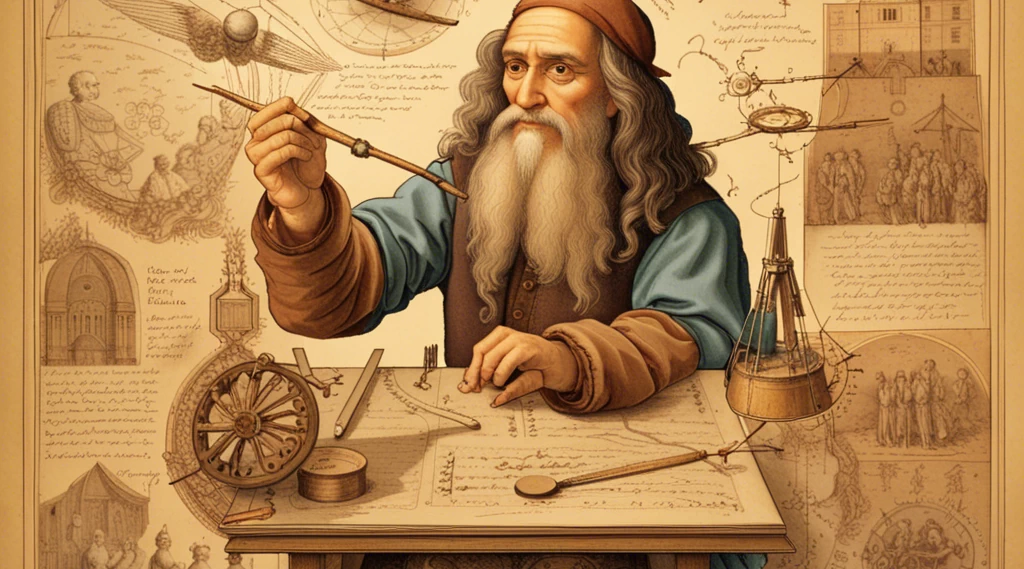—Benjamin Franklin & Leonardo Da Vinci
Throughout history, numerous individuals have left an indelible mark on the world through their exceptional achievements and profound influence. Two such remarkable figures are Benjamin Franklin and Leonardo da Vinci. Despite belonging to different time periods and geographical locations, these polymaths shared a unique ability to excel in multiple disciplines and make significant contributions to various fields.
In this comparative study, we will delve into the lives and works of Benjamin Franklin and Leonardo Da Vinci, exploring their commonalities, differences, and the impact they had on their respective societies. By examining their accomplishments in various domains, such as science, art, philosophy, and innovation, we aim to highlight the extraordinary intellect, revolutionary ideas, and enduring legacies of these two iconic figures.
This study will not only shed light on the remarkable achievements of Franklin and da Vinci but also explore the underlying factors that contributed to their success. We will analyze their educational backgrounds, personal characteristics, and the cultural contexts in which they operated, seeking to uncover the key elements that propelled them to greatness.
By comparing and contrasting the lives and works of Benjamin Franklin and Leonardo da Vinci, we hope to gain a deeper understanding of the diverse paths to intellectual brilliance and the universal attributes that transcend time and place. Through this exploration, we can draw valuable insights and inspiration from these extraordinary men, inspiring us to push the boundaries of our own capabilities and strive for greatness in our chosen endeavors.
Join us as we embark on a captivating journey through the lives of Benjamin Franklin and Leonardo da Vinci, witnessing firsthand the transformative power of human intellect, creativity, and curiosity.
Brief Summary of Two Books
Benjamin Franklin
“Benjamin Franklin” by Walter Isaacson is a comprehensive biography that delves into the extraordinary life of one of America’s founding fathers. The book explores Franklin’s multifaceted persona as a scientist, inventor, writer, diplomat, and statesman. Isaacson skillfully narrates Franklin’s journey from his humble beginnings as a printer’s apprentice in Boston to becoming a prominent figure both in America and abroad.
The biography highlights Franklin’s insatiable curiosity and his unwavering commitment to self-improvement. Isaacson portrays him as a man driven by practicality, emphasizing Franklin’s inventions such as the lightning rod, bifocals, and the Franklin stove, which showcased his ingenuity and desire to improve everyday life.
Additionally, the book elucidates Franklin’s pivotal role in shaping American history. From his efforts in drafting the Declaration of Independence to his diplomatic missions in France during the Revolutionary War, Franklin’s contributions were instrumental in securing American independence and forging crucial alliances.
Isaacson also delves into Franklin’s personal life, capturing his complex relationships with family, friends, and colleagues. Moreover, the biography sheds light on Franklin’s intellectual pursuits, his passion for writing, and his influential role in establishing public libraries and educational institutions.
Overall, “Benjamin Franklin” offers readers a captivating exploration of a remarkable individual whose impact extended far beyond his time, revealing the essence of a man who embodied the ideals of the American Dream through his intellect, creativity, and dedication to progress.
Leonardo Da Vinci
“Leonardo Da Vinci” by Walter Isaacson is a captivating biography that delves into the life and genius of the renowned artist, scientist, and inventor. The book explores the extraordinary mind of Leonardo Da Vinci, highlighting his insatiable curiosity, relentless observation, and keen intellect.
Isaacson takes readers on a journey through Da Vinci’s early life in Vinci, Italy, tracing his education, apprenticeship, and the influences that shaped him. The author examines Da Vinci’s artistic techniques, masterpieces such as the “Mona Lisa” and “The Last Supper,” and his ability to capture human expression and movement with unparalleled skill.
Beyond his artistic accomplishments, the book delves into Da Vinci’s scientific endeavors, including his fascination with anatomy, botany, geology, and engineering. Isaacson explores Da Vinci’s notebooks and reveals the breadth and depth of his scientific observations, sketches, and inventions.
Throughout the narrative, Isaacson emphasizes Da Vinci’s interplay between art and science, showcasing how his creative thinking crossed disciplinary boundaries. He also sheds light on Da Vinci’s personal life, relationships, and challenges faced as a gay man living during the Renaissance.
In summary, “Leonardo Da Vinci” offers a comprehensive and engaging portrait of one of history’s most fascinating figures, exploring his artistic brilliance, scientific inquiries, and multidimensional personality. Isaacson skillfully brings Da Vinci’s life and work to life, leaving readers inspired by his limitless imagination and enduring legacy.

Comparison Between the Two Books
Similarities in Success
While Benjamin Franklin and Leonardo da Vinci lived in different eras and pursued diverse fields of expertise, there are several notable similarities when it comes to their paths to success. Here are some key aspects that connect these two remarkable individuals:
Multidisciplinary Approach:
Both Franklin and da Vinci were polymaths, displaying a wide range of skills and interests. They excelled in various areas such as science, art, engineering, and literature. This multidisciplinary approach allowed them to explore different disciplines, merge ideas from various fields, and make groundbreaking contributions.
Curiosity and Intellectual Exploration:
Both men possessed an insatiable curiosity and a thirst for knowledge. They were driven by a relentless desire to understand the world around them. Franklin’s love for learning is evident in his autobiography, where he recounts his pursuit of self-improvement through reading and experimentation. Da Vinci’s notebooks reveal his immense curiosity about anatomy, nature, and the physical world.
Grit and Perseverance:
Franklin and da Vinci were both hardworking and persistent in the face of challenges. They dedicated countless hours to their endeavors, often sacrificing personal comfort and leisure time. Franklin’s journey from humble beginnings to becoming a prominent statesman exemplifies his determination. Similarly, da Vinci’s commitment to honing his artistic skills and pushing the boundaries of scientific understanding reflects his unwavering perseverance.
Embracing Failure and Learning from Mistakes:
Both individuals embraced failure and saw it as an opportunity for growth. Franklin’s famous quote, “I haven’t failed. I’ve just found 10,000 ways that won’t work,” epitomizes his attitude towards setbacks. Da Vinci, too, experienced failures but viewed them as stepping stones toward improvement. They recognized that learning from mistakes was crucial for achieving success.
Innovation and Out-of-the-Box Thinking:
Franklin and da Vinci were known for their innovative ideas and unconventional thinking. They constantly sought new solutions to problems and were unafraid to challenge established norms. Franklin’s inventions, such as the lightning rod and bifocals, revolutionized their respective fields. Da Vinci’s visionary designs, ranging from flying machines to anatomical studies, showcased his inventive spirit.
Entrepreneurial Spirit:
Both men displayed entrepreneurial instincts and used their skills to create opportunities for themselves. Franklin established successful printing businesses, publishing ventures, and created public institutions. Da Vinci actively sought patronage for his art and engineering projects, leveraging his talent to secure financial support.
These similarities highlight how Benjamin Franklin and Leonardo da Vinci shared certain traits that contributed to their success. Their multidisciplinary approach, curiosity, perseverance, openness to failure, innovation, and entrepreneurial mindset were key factors in their achievements. By drawing inspiration from these remarkable figures, individuals can learn valuable lessons on how to pursue their own paths to success.

Divergences in Success
While both Franklin and da Vinci achieved notable success during their lifetimes, there are some key divergences in terms of the nature of their achievements and the recognition they received:
Recognition in their lifetimes:
Franklin enjoyed considerable recognition and acclaim during his lifetime. He was a well-known figure in politics, diplomacy, and publishing. On the other hand, da Vinci’s accomplishments were not fully recognized during his time. Many of his inventions and artistic works remained unpublished or incomplete, and his genius was not widely acknowledged until after his death.
Fields of focus:
Franklin’s success primarily stemmed from his contributions in the fields of science, inventions, and politics. His experiments with electricity and the formulation of his famous “Franklin stove” brought him widespread recognition. In contrast, da Vinci’s success spanned multiple domains, including art, anatomy, engineering, and scientific inquiry. His paintings like the Mona Lisa and The Last Supper are considered timeless masterpieces.
Cultural impact:
Franklin’s success had a significant impact on American society and culture. His writings, such as “Poor Richard’s Almanack” and “The Autobiography of Benjamin Franklin,” have influenced generations of Americans. Da Vinci’s impact, on the other hand, extends globally and transcends time. His artistic works continue to inspire admiration and awe, and his scientific concepts have influenced future generations of inventors and researchers.
In summary, while both Benjamin Franklin and Leonardo da Vinci were exceptional individuals who achieved notable success, their areas of focus, recognition during their lifetimes, and cultural impact differ. Franklin’s success was more focused on his scientific inventions and political contributions, leading to recognition in his time and a lasting impact on American culture. In comparison, da Vinci’s achievements were broader and encompassed various fields, resulting in worldwide recognition posthumously and a lasting cultural impact on a global scale.
Conclusion
Both “Benjamin Franklin” and “Leonardo Da Vinci,” written by Walter Isaacson, are highly esteemed biographies that offer fascinating insights into the lives of two extraordinary individuals. Here is a brief comparison to help you decide which book may be more worthy of your reading:
Benjamin Franklin:
Synopsis: This biography delves into the life of one of America’s founding fathers, Benjamin Franklin. It explores his multifaceted achievements as a statesman, inventor, writer, and scientist.
Key Highlights: Franklin’s role in shaping the American Revolution, his experiments with electricity, his contributions to the drafting of the Declaration of Independence, and his philosophical ideas.
Relevance: If you are interested in American history, politics, science, or the Enlightenment era, this book presents an engaging and comprehensive account of Franklin’s life.
Leonardo Da Vinci:
Synopsis: Walter Isaacson brings to life the genius of Leonardo da Vinci, the renowned Italian artist, inventor, and visionary. The biography examines his artistic masterpieces, scientific explorations, and curious mind.
Key Highlights: Leonardo’s iconic paintings (such as the Mona Lisa and The Last Supper), his engineering and anatomical studies, his innovative inventions, and his relentless curiosity about the world.
Relevance: If you are intrigued by Renaissance art, science, engineering, or are inspired by the creative process, this book provides a captivating exploration of Leonardo’s accomplishments and the historical context in which he lived.
Ultimately, the choice between the two books depends on your personal interests and what you hope to gain from reading a biography. Both Benjamin Franklin and Leonardo da Vinci left indelible marks on history, and Walter Isaacson’s meticulous research and vivid storytelling make either book a worthwhile read.


